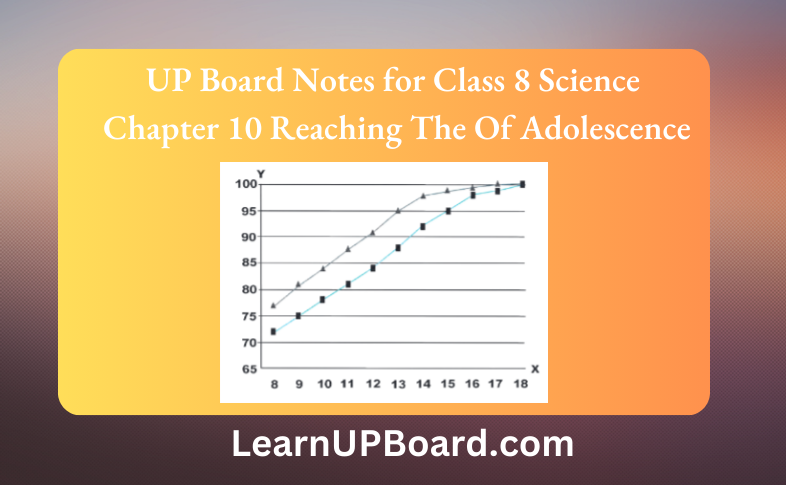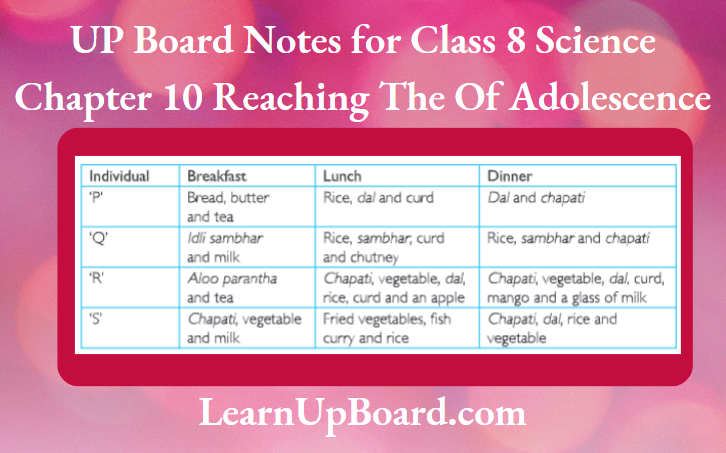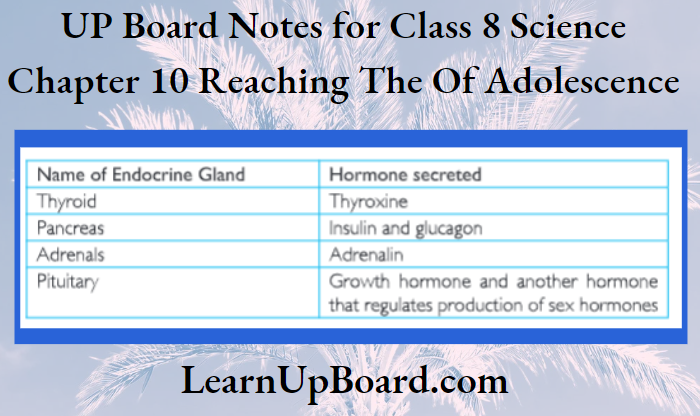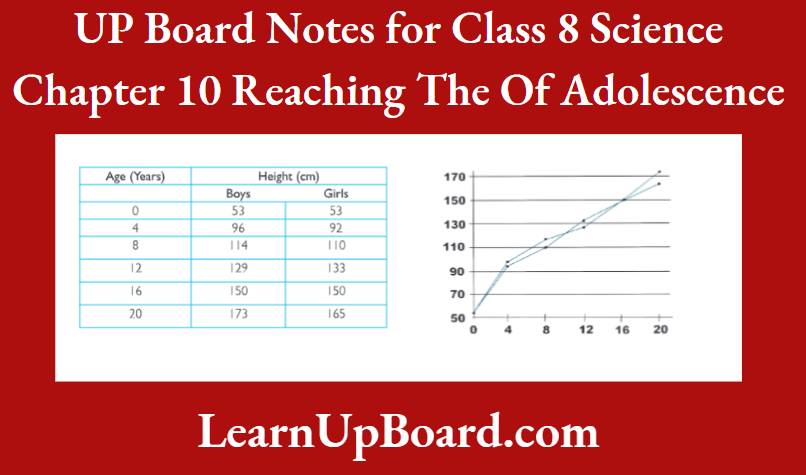UP Board Notes For Class 8 Science Chapter 10 Reaching The Of Adolescence Chapter Objectives
- Adolescence is the period of transition from childhood to adulthood during which the human body undergoes changes leading to reproductive maturity. It starts from the age of II and continues till 18 or 19 years of age.
- Sweat and sebaceous glands become more active during adolescence causing acne and pimples on the face of boys and girls during this period.
- Reproductive organs become fully functional during adolescence. In boys, testes start producing sperm and in girls, ovaries enlarge and start releasing eggs.
- Larynx is the voice-producing area present in the throat. Puberty leads to change in the voice of boys and girls. Boys; voice becomes deep and those of girls become high-pitched.
- Hormones produced by endocrine glands control the changes that take place during adolescence.
- Endocrine glands secrete hormones directly into the bloodstream. Hence, they are also known as ductless glands.
- Testosterone, the male hormone, is released by the testes. It helps in sperm production.
- Estrogen, the female hormone, is released by the ovaries and it enables eggs to mature in the ovaries. Testosterone and estrogen are known as sex hormones. They also help in the development of secondary sexual characters.
- Thyroid gland, located in the throat region, produces thyroxine.
- Thyroxine controls the rate of metabolism, growth, and respiration.
- Goitre, a disease of the thyroid gland, occurs due to the deficiency of iodine in diet.
- Adrenalin, produced by adrenal glands, helps the body to adapt to stress, anger, embarrassment, or worry.
- All human beings have 23 pairs of chromosomes in the nuclei of their cells. Two chromosomes out of these are sex chromosomes.
Read and Learn More UP Board Notes for Class 8 Science
UP Board Notes For Class 8 Science Chapter 10 Reaching The Of Adolescence Important Terms And Definitions
Adam’s apple: The protruding part of the throat in boys is referred to as the Adam’s apple.
Secondary Sexual Characters: Features that help to distinguish males from females such as facial and chest hair in males and breasts in females are known as secondary sexual characters.
Ovulation: The release of a mature egg from one of the ovaries after every 28 to 30 days is called ovulation.
Menstruation: It is the bleeding that occurs in females every month and continues for 3-5 days.
Menarche: It the first menstrual flow that occurs at puberty.
UP Board Notes For Class 8 Science Chapter 10 Reaching The Of Adolescence Adolescence And Puberty
Adolescence is the period during which the human body undergoes changes leading to reproductive
maturity. Adolescence starts at age of II and continues till 18 or 19 years of age. Puberty refers to the process of physical changes that happens to child’s body leading to sexual maturity. The child changes into an adult capable of sexual reproduction.
| Class 10 Science | Class 11 Chemistry |
| Class 11 Chemistry | Transformation of Sentences |
| Class 8 Maths | Class 8 Science |
UP Board Notes For Class 8 Science Chapter 10 Reaching The Of Adolescence Activity 2
Aim: To observe the increase in the height of boys and girls with age
Procedure:
1. Use the data given in Activity I and draw a graph.
2. Mark age (in years) on the X-axis and percentage of full height on the Y-axis.
3. Highlight the point that represents your age.
4. Calculate the percentage of height you have already reached.
5. Calculate the height you might eventually reach. Tally your graph with the one shown below.

Conclusion: The rate of growth in height varies in different individuals.
UP Board Notes For Class 8 Science Chapter 10 Reaching The Of Adolescence Objective Type Questions
1. State whether the following statements are true or false.
- Boys have high-pitched voices.
- Genes inherited from parents influence the height of an individual.
- Acne in teens is caused due to the increased activity of sweat and oil glands.
- Testes in males, start producing sperm during puberty.
- Ovaries of a girl start releasing ovum soon after birth.
- During adolescence, the body’s muscles grow more prominently in boys than in girls.
Answers:
- False
- True
- True
- True
- False
- True
2. Multiple Choice Questions.
Question 1. At what age do boys and girls attain their maximum height?
- 15 years
- 20 years
- 18 years
- 16 yearsAnswers: 3) 18 years
Question 2. What is the protruding part of throat in boys called?
- An apple
- Adam’s apple
- Adam’s box
- None of theseAnswers: 2) Adam’s apple
Question3. Due to which of the following reasons does the voice of boys change during puberty?
- Increased activity of oil glands
- Development of sex organs
- Brain’s increased capacity for learning
- Growth of voice boxAnswers: 4) Growth of voice box
Question 4. What other name is given to adolescents?
- Adults
- Teenagers
- Newborn babies
- None of these Answers: 2)Teenagers
3. Fill in the blanks.
- Changes in the human body during adolescence mark the onset of______
- The period between childhood and adulthood is known as_______
- On an average, girls reach puberty at the age of______years.
- ________and sebaceous glands become more active during puberty.
Answers:
- Puberty
- Adolescence
- 11-13
- Sweat
UP Board Notes For Class 8 Science Chapter 10 Reaching The Of Adolescence Short Answer Type Questions
1. Is the adolescence and puberty the same?
Answers: Adolescence and puberty are not the same. Puberty is the process of physical changes by which adolescents reach sexual maturity, while adolescence is the period of psychological and social transition from childhood to adulthood.
Hormones and their Role in Reproduction
Answers:
Hormones
Hormones are chemical substances which control the changes that take place in human beings during adolescence. The testes in males secrete testosterone or the male hormone at the onset of puberty. It helps in the production of sperm in testes. In females, the ovaries release estrogen or the female hormone which makes the breasts develop.
UP Board Notes For Class 8 Science Chapter 10 Reaching The Of Adolescence Activity 3
Aim: To identify the importance of consuming iodised salt
Procedure:
Collect information regarding the importance of consuming iodised salt from doctors, magazines and the internet.
Observation: Thyroid gland needs iodine to produce thyroxine, which regulates the metabolic activities of the body.
Conclusion: lodine is essential for the production of thyroxine hormone, which regulates body’s metabolic activities. lodine deficiency causes a disease known as goitre.
UP Board Notes For Class 8 Science Chapter 10 Reaching The Of Adolescence Objective Type Questions
1. State whether the following statements are true or false.
- Hormones are released by endocrine glands.
- Thyroxine is a sex hormone.
- Both males and females develop hair under arms and in the pubic region.
- The male hormone testosterone is secreted by the pituitary gland.
Answers:
- True
- False
- True
- False
2. Multiple Choice Questions.
Question 1. Which hormone helps in the production of sperms?
- Estrogen
- Testosterone
- Thyroxine
- AdrenalinAnswers: 2) Testosterone
Question 2. Which of the following is the female hormone?
- Estrogen
- Testosterone
- Thyroxine
- AdrenalinAnswers: 1) Estrogen
Question 3. Which of the following are the milk-secreting glands that develop inside breasts?
- Endocrine glands
- Pituitary gland
- Thyroid
- Mammary glandsAnswers: 4) Mammary glands
Question 4. What is the role of adrenalin?
- Maintains blood sugar level
- Maintains body temperature
- Maintains the salt balance in the blood
- Maintains reproductive healthAnswers: 3) Maintains the salt balance in the blood
Question 5. Which element is essential for the formation of thyroxine hormone?
- Sodium
- lodine
- Bromine
- MagnesiumAnswers: 2) lodine
3. Fill in the blanks
- Adolescence lasts up to_____ years of age.
- The specific body part to which a hormone reaches and the body part reacts to the hormone is called the_______
- _____is also called the voice box.
- Growth hormone is produced by the_____gland.
- Hormones are the secretions of the_____gland.
Answers:
- 19
- target site
- larynx
- pituitary
- endocrine
UP Board Notes For Class 8 Science Chapter 10 Reaching The Of Adolescence Short Answer Type Questions
A. Why endocrine glands are called ductless glands?
Answers: Endocrine glands are known as ductless glands because they release their hormones directly into the bloodstream. Thyroid and pituitary glands are examples of endocrine glands.
B. Why iodine is important for us?
Answers: lodine is important for the production of thyroxine hormone, which regulates the metabolism of our body. Deficiency of iodine causes a disease called goitre.
C. Write the main characteristics of hormones.
Main characteristics of hormones are:
- Hormones are secreted by the endocrine glands.
- They have specific functions and hence, they affect specific organs only.
- Hormones are required in very little quantity.
D. Give the names of hormones secreted by the following endocrine glands.
1. Thyroid gland 2. Adrenal gland 3. Pancreas
- Thyroid gland secretes thyroxine
- Adrenal gland secrets adrenalin
- Pancreas secretes insulin and glucagon
Phases of Reproduction in Human Beings
In females, at the onset of puberty, ovaries mature and start releasing an egg every 28 to 30 days. Pregnancy occurs when an egg gets fertilised by a sperm.
UP Board Notes For Class 8 Science Chapter 10 Reaching The Of Adolescence Activity 4
Aim: To identify food items which are responsible for growth and development during adolescence
Note: This answer may vary from one student to another. Here is what a sample answer may look like.
Procedure:
- Create a group and note down the food items which you had taken on the previous day.
- Identify the items that enable proper growth.

Conclusion:
- A balanced diet includes carbohydrates, fats, vitamins, proteins, minerals, water and fibers in appropriate quantities.
- Food items such as burgers, chips, tinned snacks are not good for health and should be consumed only occasionally.
UP Board Notes For Class 8 Science Chapter 10 Reaching The Of Adolescence Activity 5
Aim: To spread awareness about the benefits of a balanced diet
Procedure:
- Prepare posters, charts depicting items that make-up a balanced diet.
- Display these charts and posters in your class.
Conclusion:
A balanced diet consists of all the nutrients, carbohydrates and fats, vitamins, water, minerals, and fibers, in the proper proportion. It is needed to provide energy to the body, to facilitate the formation of blood, bones, and teeth, to regulate body functions, to initiate chemical reactions in the body, and to have a healthy digestive system.
UP Board Notes For Class 8 Science Chapter 10 Reaching The Of Adolescence Activity 6
Aim: To prepare a report on the advantages of regular exercise
Procedure:
- Find out how many of your classmates exercise regularly and how many don’t.
- Observe and note down the difference in their fitness level.
Observation:
- The classmates who exercise regularly are energetic, more alert and have a better immune system.
- The classmates who do not exercise are lethargic, lack focus and are often unwell. Conclusion: Physical exercises such as walking, running and playing outdoor games increase physical and mental health.
UP Board Notes For Class 8 Science Chapter 10 Reaching The Of Adolescence Objective Type Questions
1. State whether the following statements are true or false.
- Females attain reproductive maturity between the ages of 10 to 12 years.
- Menopause occurs around the age of 30 to 40 years.
- Testosterone is a female hormone.
- Sex chromosome in human males consists of two X chromosomes.
- Reproductive life of a woman lasts till menopause.
Answers:
- True
- False
- False
- False
- True
UP Board Notes For Class 8 Science Chapter 10 Reaching The Of Adolescence Multiple Choice Questions
Question 1. Which of the following is the process wherein one of the ovaries produces an egg or ovum, after it matures, in every 28 to 30 days?
- Menstruation
- Ovulation
- Menarche
- Menopause
Answers: 2)Ovulation
Question 2. Which of the following is not included in the menstrual cycle?
- Release of egg
- Maturing of egg
- Fertilisation
- dShedding of uterus wall
Answers: 3)Fertilisation
Question 3. How many pairs of sex chromosomes are present in human beings?
- One
- Two
- Three
- Four
Answers: 1) One
Question 4. Where does fertilisation in human beings take place?
- Fallopian tube
- Uterus
- Vagina
- All of these
Answers: 1) Fallopian tube
Fill in the blanks.
- ________is the first menstrual flow.
- The bleeding that occurs in females after every 28 to 30 days is called_______
- Insulin is secreted by the_______
- Human beings have_________pairs of chromosomes.
- The male hormone testosterone is secreted by_______
- In human beings, the_______is responsible for determining the sex of the child.
Answers:
- Menarche
- Menstruation
- Pancreas
- 23
- Testes
- Sex chromosome
UP Board Notes For Class 8 Science Chapter 10 Reaching The Of Adolescence Short Answer Type Questions
1. Why is adolescent pregnancy harmful?
Answers: It is harmful because a teenage mother is neither mentally nor physically capable of taking the responsibility of motherhood and coping with its challenges. Early motherhood leads to health problems in both the mother and the child.
2. What is the meaning of reproductive health?
Answers:
Reproductive health meaning
According to the World Health Organization (WHO), reproductive health means a total well being in all aspects of reproduction, i.e., physical, emotional, behavioural and social health.
UP Board Notes For Class 8 Science Chapter 10 Reaching The Of Adolescence Textbook Exercises
Question 1. What is the term used for secretions of endocrine glands responsible for changes taking place in the body?
Answers: Hormones
Question 2. Define adolescence.
Answers:
Adolescence:
The period during which the human body undergoes changes leading to reproductive maturity is called adolescence. It begins at the age of 11 years and ends between the age of 18 to 19 years.
Question 3. What is menstruation? Explain.
Answers:
Menstruation Cycle
In females, an ovum matures and is released by one of the ovaries once in about every 28 to 30 days. If the egg is not fertilized by a sperm, it is released out from the body along with the thickened lining of the uterus. This causes monthly bleeding in women and is called menstruation.
Question 4. List changes in the body that take place at puberty.
Answers:
The following changes take place in the body at puberty:
- The most noticeable change is the increase in the height of adolescents.
- The voice box or the larynx grows during puberty resulting in a change in voices of both the boys
and girls. - The increased activity of sweat and sebaceous glands during puberty results in acne and pimples
on the face. - The male sex organs (testes and penis) develop fully during this period and testes start producing
sperms. In girls, the ovaries expand, eggs mature and ovaries start releasing matured eggs.
Question 5. Prepare a table having two columns depicting names of endocrine glands and hormones secreted by them.

Question 6. What are sex hormones? Why are they named so? State their functions.
Answers:
Sex hormones
Testosterone and estrogen are called sex hormones. Testosterone is the male hormone secreted by testes at the start of puberty. Estrogen is the female hormone secreted by ovaries. It makes the egg mature. These hormones help in the development of secondary sexual characters and hence are called sex hormones.
Question 7. Choose the correct option.
1. Adolescents should be careful about what they eat, because:
- Proper diet develops their brains.
- Proper diet is needed for the rapid growth taking place in their body.
- Adolescents feel hungry all the time.
- Taste buds are well-developed in teenagers.
Answers: (2) Proper diet is needed for the rapid growth taking place in their body
2. Reproductive age in women starts when their:
- Menstruation starts
- Breasts start developing
- Body weight increases
- Height increases
Answers: (1) Menstruation starts
3. The right meal for adolescents consists of:
- Chips, noodles, coke
- Chapatti, dal, vegetables
- Rice, noodles and burger
- Vegetable cutlets, chips and lemon drink
Answers: (2) Chapatti, dal, vegetables
Question 8. Write notes on:
- Adam’s apple
- Secondary sexual characters
- Sex determination in the unborn baby
Answers:
- Adam’s Apple: The protruding part of the throat in boys is the growing voice box. It is called the Adam’s apple.
- Secondary sexual characters: Features which help in distinguishing a man from a woman are called secondary sexual characters. In males, the secondary sexual characters are growth of hair on face, chest, under arms, and pubic region. In females, the development of breasts and growth of hair in the under arm and pubic regions are the secondary sexual characters.
- Sex determination in the unborn baby: The sex of an unborn child depends on whether the zygote has XX or XY chromosomes. If the zygote has one X and one Y chromosome, it develops into a male child. On the other hand, if the zygote has two X chromosomes, it develops into a female child.
Question 9. Word game: Use the clues to work out the words.
Across:
- Protruding voice box in boys
- Glands without ducts
- Endocrine gland attached to brain
- Secretion of endocrine glands
- Pancreatic hormone
- Female hormone
Down:
- Male hormone
- Secretes thyroxine
- Another term for teenage
- Hormone reaches here through bloodstream
- Voice box
- Term for changes at adolescence

Across:
- Adam’s apple
- Endocrine
- Pituitary
- Hormone
- Insulin
- Estrogen
Down:
- Testosterone
- Thyroid
- Adolscence
- Target site
- Larynx
- Puberty
Question 10. The table given below shows the data on the likely height of boys and girls as they grow in age. Draw graphs showing the height and age of both boys and girls on the same graph paper. What conclusions can be drawn from these graphs?
The graph is given below:

It can be seen from the graph that girls at the age of 12 are generally taller than boys. At 16 years, the height of both is the same but eventually boys gain height and become taller than girls.
UP Board Notes For Class 8 Science Chapter 10 Reaching The Of Adolescence Hots corner
A. How will a human body be affected if the thyroid gland is removed from the body?
Answers: Thyroid gland releases thyroxine, which regulates metabolism, maturation and growth.. If it is removed, the growth and metabolic activities of human beings will be adversely affected.
UP Board Notes For Class 8 Science Chapter 10 Reaching The Of Adolescence Practice Exercises Objective Answer Type Questions
1. Select the odd one out
- Endocrine gland, Pituitary gland, Adrenals, Oil gland
- Testosterone, Estrogen, Insulin, Ovaries
- AIDS, Goitre, Diabetes, Menstruation
Answers:
- Oil gland
- Ovaries
- Menstruation
2. Give one word for the following.
- The master gland in our body.
- The milk secreting gland in human females.
- The hormone secreted by the adrenals.
- The process in which mature ovum is released from the ovary.
Answers:
- Pituitary gland
- Mammary Glands
- Adrenalin
- Ovulation
3. State whether the followire true or falseng statements a.
- During puberty, the voice box grows more in boys than in girls.
- Goitre is caused due to the lack of thyroxine.
- Mother’s chromosomes are responsible for the sex of the child.
- The adrenals are responsible for causing acne in teenagers.
Answers:
- True
- True
- False
- False
4. Fill in the blanks.
- ______is a female hormone_____
- _____is a male hormone.
- Salivary gland is a type of_____ gland.
Answer:
- Estrogen
- Testosterone
- Exocrine
UP Board Notes For Class 8 Science Chapter 10 Reaching The Of Adolescence Short Answer Type Questions
1. It is assumed that an 8-years old child will attain about 72% of his or her full height at the end of the growth period. If the child is 108 cm tall now, what would his or her height at the end of the growth period?
Answers:
Current age of child = 8 years
Current height of child = 108 cm
According to the formulas
Full height of the child =
current height of child
% of full height
108
= .*100=
12
-x100
150 cms.
Also Read
- Chapter 1 Crop Production and Management
- Chapter 2 Microorganisms: Friend and Foe.
- Chapter 3 Synthetic Fibres and Plastics
- Chapter 4 Materials: Metals and Non-Metals
- Chapter 5 Coal and Petroleum
- Chapter 6 Combustion and Flame
- Chapter 7 Conservation of Plants and Animals
- Chapter 8 Cell: Structure and Functions
- Chapter 9 Reproduction in Animals
- Chapter 11 Force and Pressure
- Chapter 12 Friction
- Chapter 13 Sound
- Chapter 14 Chemical Effects of Electric Current
- Chapter 15 Some Natural Phenomena
- Chapter 16 Light
- Chapter 17 Stars and the Solar System
- Chapter 18 Pollution of Air and Water
